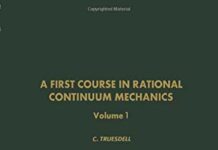
Ebook Info
- Published: 2011
- Number of pages: 372 pages
- Format: PDF
- File Size: 16.11 MB
- Authors: C. Truesdell
Description
User’s Reviews
Reviews from Amazon users which were colected at the time this book was published on the website:
⭐Truesdell describes the evolution of thermodynamics between the critical dates 1822-1854 as a field “accursed by misunderstanding, irrelevance, retreat, and failure” (p.1). The author constructs a history of thermodynamics in its formative years as it haltingly advanced. Among the many milestones mentioned is Laplace’s erroneous characterization of heat as a corpuscular entity (p.32). An even sharper critique is reserved for Fourier and his lack of concern for accurately defining temperature (p.76), to the point where the author dismisses Fourier’s work in this field as “divergent gobbledygook” (p.77).The most detailed of the author’s discussions focus on Carnot, whose 1824 work is seen as strangely void of actual mathematics (p.80). Most of what is considered Carnot’s contributions are largely due to the transcription of his work by Clapeyron in 1834 (p.139)–who added the diagrams and mathematics with which we are now familiar. This tendency to settle for a largely verbal description of thermodynamics instead of one nested in mathematics was brought to light again by the work of Clausius on entropy, to the point where the author felt compelled to observe that “Clausius, like Carnot [was a] penetrating student of nature but a feeble mathematician” (p.185).A more complete development of Carnot’s ideas awaited the involvement of French naval engineer Ferdinand Reech. In 1851 Reech published “a deadly memoir 211 pages long, dense with equations” (p.236). Among Reech’s achievements was introducing “a function that generalizes what Clausius was later to call entropy” (p.280). Reech also generalized the definition of internal energy (p.281). Although Reech’s work (1851) was published well in advance of Clausius (1854), Reech received little credit, due in part to the face that “Reech shows none of Clausius’ greed for priority and recognition” (p.300). Clausius even went so far as to disingenuously cite Reech’s 1851 work on entropy and the 2nd law of thermodynamics as that which “reproduced” Clausius’ own work published in 1854 (p.298)! At least Reech was given credit for the primacy of his work on entropy by the first textbook on thermodynamics, written by Zeuner, which appeared in 1860. “Zeuner attributed to Reech an argument leading to Claussius’ second principle theorem of 1854.” According to Truesdell, however, the argument reproduced by Zeuner was actually due to Rankine (p.298).Truesdell sums up his view on the sad state of 19th century physics teaching by observing that “mathematical research meanwhile advanced swiftly, but little of it was learnt by physicists” (p.339).
⭐Not found.
Keywords
Free Download The Tragicomical History of Thermodynamics, 1822–1854 (Studies in the History of Mathematics and Physical Sciences, 4) in PDF format
The Tragicomical History of Thermodynamics, 1822–1854 (Studies in the History of Mathematics and Physical Sciences, 4) PDF Free Download
Download The Tragicomical History of Thermodynamics, 1822–1854 (Studies in the History of Mathematics and Physical Sciences, 4) 2011 PDF Free
The Tragicomical History of Thermodynamics, 1822–1854 (Studies in the History of Mathematics and Physical Sciences, 4) 2011 PDF Free Download
Download The Tragicomical History of Thermodynamics, 1822–1854 (Studies in the History of Mathematics and Physical Sciences, 4) PDF
Free Download Ebook The Tragicomical History of Thermodynamics, 1822–1854 (Studies in the History of Mathematics and Physical Sciences, 4)




